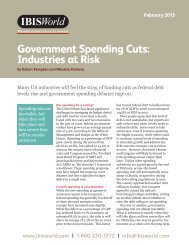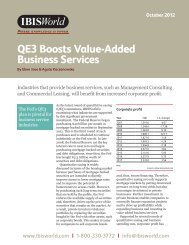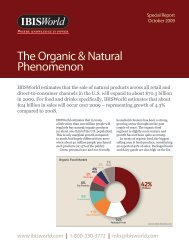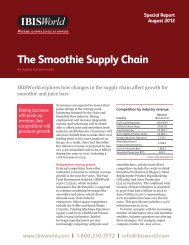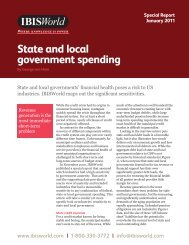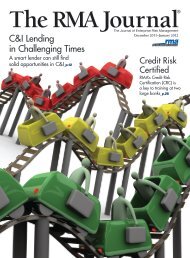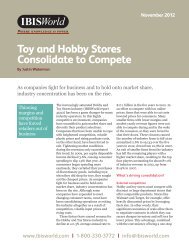Problem Areas Credit Risk - IBISWorld
Problem Areas Credit Risk - IBISWorld
Problem Areas Credit Risk - IBISWorld
Create successful ePaper yourself
Turn your PDF publications into a flip-book with our unique Google optimized e-Paper software.
Table 1<br />
Industry<br />
Purchase Costs<br />
(% of total revenue)<br />
Profit Rate<br />
(% of revenue)<br />
Price-shock Vulnerability Checklist<br />
Implied Input Price<br />
Rise 'Buffer'<br />
Industry Life-<br />
Cycle Stage<br />
Average Size of<br />
Industry Company ($)<br />
<strong>IBISWorld</strong> Industry<br />
Health Index<br />
Beef Cattle Production 48.8 15.0 30.7 Mature 73,365 106.1<br />
Milk Production & Dairy Cattle 51.9 13.0 25.0 Mature 502,688 99.3<br />
Hog & Pig Farming 50.0 14.0 28.0 Decline 481,334 103.7<br />
Chicken Production 52.2 18.5 35.4 Mature 968,033 119.2<br />
Turkey Production 44.0 14.1 32.0 Mature 1,176,110 123.6<br />
Animal Food Production 61.0 19.6 32.1 Mature 21,721,465 110.8<br />
Egg & Poultry Wholesale 83.0 4.0 4.8 Decline 10,859,586 79.1<br />
Beef & Pork Wholesale 83.6 2.5 3.0 Decline 9,760,094 77.6<br />
industry might bear a short-term increase in input costs<br />
of only 3% before considering passing on prices or threatening<br />
default. These pressures are likely to accelerate the<br />
general move toward wholesale function bypass and play<br />
to the strengths of vertically integrated agribusinesses that<br />
grow, process, wholesale, and even retail goods.<br />
The saving grace of the wholesale sector is the large<br />
average size of an industry operator. Buying power is a<br />
key pressure point along any supply chain. In comparison<br />
to most farmers, wholesale firms have a high degree of<br />
bargaining power in the supply chain. Firms at or larger<br />
than the benchmarks noted can use economies of scale in<br />
purchasing, storage, and distribution that a smaller company<br />
would find more difficult. The discrepancy in establishment<br />
size is a fair indication of one company’s power<br />
compared with another.<br />
Evidence of the way supply-chain dynamics operate<br />
is calculable. According to the U.S. Department of Agriculture<br />
(USDA), the retail price of beef increased 16.6%<br />
between 2002 and 2007, and all of this occurred between<br />
wholesalers and retailers. A comparison of the farm gate<br />
price of beef and the wholesale price shows a fall of 6.2%<br />
over the same period. Clearly, the discrepancy between<br />
average farm size and average wholesaler and manufacturer<br />
is vital.<br />
Supply-chain credit risk is mitigated by reasonably high<br />
average profit margins, which operators can use as a shortterm<br />
buffer against price shocks before passing the price<br />
to consumers (or further down the supply chain) or, in the<br />
worst-case scenario, before credit default.<br />
The animal food production industry is particularly<br />
well sheltered with a significant average establishment<br />
size (manufacturing is reliant on economies of scale that<br />
reduce unit prices) and a profit margin touching 20%<br />
of revenue. The buffer in this industry’s cost structure is<br />
32.1%. Although purchase costs are reasonably high, they<br />
are spread across crop and noncrop industries.<br />
Moreover, the mature stage of the industry life cycle<br />
allows the best companies to segment their product offerings.<br />
Higher-quality goods will probably be marked up<br />
in price at the retail level (pet food accounts for around<br />
30% of industry revenue), while lower-end goods (such as<br />
cattle feed) will benefit from some near-term price crosssubsidization.<br />
The <strong>IBISWorld</strong> Industry Health Index shows an average<br />
score across all industries in the chain of 102.4—ranging<br />
from a very healthy 123.6 points for turkey production to<br />
a low of 77.6 points in the beef and pork wholesale industry.<br />
Turkey producers are aided by the fact that purchase<br />
costs account for only 44% of total revenue (the lowest in<br />
this supply chain). Of that total, only about 15 percentage<br />
points come from crops (as used for feed). Further along<br />
the turkey production supply chain, operators are helped<br />
by the high price of turkey livestock, a low incidence of<br />
disease, and changing consumer consumption habits favoring<br />
white meat.<br />
Three industries fall below the baseline 100 level, suggesting<br />
relatively poor health. In the case of the milk production<br />
and dairy cattle industry, problems stem from the<br />
industry operators’ reliance on crops as feed. <strong>IBISWorld</strong><br />
estimates that crops account for about 20 percentage<br />
points of purchase costs (which total 51.9% of revenue).<br />
The industry also suffers from a weakening supply chain<br />
of its own. Key buyers, such as the dairy product manufacturing<br />
industry, which accounts for about 30% of total<br />
demand, will grow only 0.6% in 2009. Another key buyer,<br />
the ice cream manufacturing industry, will decline 0.9%.<br />
Agriculture and the Food Production Chain<br />
The benchmark checklist for industries in the food production<br />
supply chain (Table 2) has two industries in the<br />
growth stage of their life cycles: the tortilla production<br />
industry and corn, wheat, and soybean wholesaling. On<br />
closer inspection of the latter, we find that expansion is<br />
concentrated in the corn segment, especially sales to producers<br />
of ethanol and other biofuels. Expansion in this<br />
The RMA Journal October 2008 45



